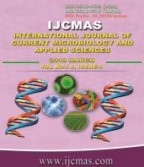


 National Academy of Agricultural Sciences (NAAS)
National Academy of Agricultural Sciences (NAAS)

|
PRINT ISSN : 2319-7692
Online ISSN : 2319-7706 Issues : 12 per year Publisher : Excellent Publishers Email : editorijcmas@gmail.com / submit@ijcmas.com Editor-in-chief: Dr.M.Prakash Index Copernicus ICV 2018: 95.39 NAAS RATING 2020: 5.38 |
Exact prediction of the cooling and heating load, proper sizing of the heat ventilation air-conditioning (HVAC) system and optimal control of the HVAC systems are important to minimize energy consumption. Calculation of thermal load of building is very essential to find exact air-conditioning equipment and air handling unit, to achieve comfort operation and good air distribution in the air-conditioned zone. This project Cooling load estimation for a Reading Hall of CAET, JAU presents by using TETD method. The Reading Hall considered in this study is situated in Junagadh (70.45°E, 21.52°N) district of Gujarat, India and elevation of about 107 meters above mean sea level. Junagadh has a tropical wet and dry climate. During monsoon, it receives high rainfall and retreats Northeast monsoon. The total heat required to be removed from the space in order to bring it at the desired temperature (21 – 26 °C) and relative humidity (60%) by the air conditioning equipment is known as cooling load or conditioned load. This load consists of external and internal loads. The cooling load of the Reading Hall is dependent on local climate, thermal characteristics of material and type of building. For calculating a cooling load using the transfer function method is to use the one step procedure, which was first presented in the ASHRAE Handbook of Fundamentals in the year 2005. This method is called the Total Equivalent temperature differences (TETD) method. In this method, hand calculation is used to calculate cooling load. The results show that the total cooling load for the AC required Reading Hall is 19.74 tons for summer (month of May). The m2/ton for the Reading Hall is about 18.83 m2/ton for summer, which is approximately same, comparing with the standard value about 20 m2/ton. The average sensible heat ratio of the Reading Hall is 0.74 for summer.
 |
 |
 |
 |
 |